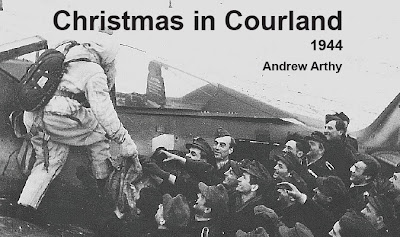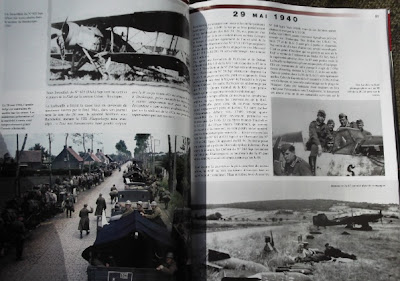Air War Publications launch an innovative series of eArticles this week. They are published in printable PDF format so that they can be read on a computer, laptop or tablet - or indeed printed out and read conventionally - and are fully illustrated with rare aircraft and pilot photographs, aircraft profiles, colour maps and unit emblems. The first Air War Publications eArticle -written by Andrew Arthy and expertly laid-out and presented by Morten Jessen- tells the story of the Luftwaffe flying units in the encircled Courland Pocket on 25 December 1944, and relates the series of successful ground-attack and fighter operations flown over the front that Christmas Day and the attempts by the pilots and ground personnel to celebrate the day despite being cut off from their homeland. The 15-page article - available from the Air War Publications web site for just a few euros - includes numerous first-hand accounts from the men who were there. As far as I am aware this is the first time that Stukageschwader 3 pilot Erhard Jähnert has related his experiences in English - as Andrew notes in the article, despite having flown 583 missions prior to 25 December 1944 and having been awarded the Ritterkreuz, Christmas Day 1944 was a day that changed things for him. The rare accounts of sorties flown by the rocket-firing Fw 190s of his unit are worth the minimal cost of this article on their own for me. I have no doubt that the subject will be of considerable interest to all Luftwaffe enthusiasts. I believe this first eArticle is adapted from Andrew's forthcoming work 'Air War Courland' and is an excellent taster for that volume. And while admiring the high quality content of this first eArticle I can also report that Morten's work on lay-out and presentation is first class - if you are familiar with his work in the authors' Fw 190 in the Battle for Sicily book reviewed elsewhere on this blog then you know what to expect. Morten and Andrew tell me that this will hopefully be the first of many eArticles. Also released this week by Air War Publications is a biography of Fritz Schröter while the following future titles are currently in preparation;
- ‘The Death of the Top Mustang Ace’ by John Beaman
- ‘Camouflage Commentary 1: Unit Identity of Fw 190 A-8 WNr. 175 140 and Use of Colour RLM 77’ by David E. Brown
- ‘Jagdgeschwader 2 Aces’ by Leo Etgen & Andrew Arthy
- ‘1. Wüstennotstaffel’ by Adam Thompson & Andrew Arthy
- ‘Hampden in Swedish Service’ by Mikael Olrog
This latest initiative from the talented duo of Jessen and Arthy is an excellent way for enthusiasts to follow the latest research by a variety of well respected authorities without having to meet the considerable expense of purchasing the latest hard back book, which in the current climate has to be a good thing. Of course some of these subjects do not necessarily warrant a book or would be prohibitively expensive to produce in book form even if they did. Given the lengthy gestation periods involved with book production, Air War Publications' eArticles seem to me to be an excellent and innovative alternative for enthusiasts and prospective readers to keep abreast of the latest information. All in all Air War Publications appear to have an excellent variety of subjects in preparation!
A more conventional publication is the latest in Lela Presse's quarterly air war history series "Batailles Aeriennes". With new books on Luftwaffe fighter pilot aces and Stuka aces under his belt, this latest issue of "Air Battles" by noted Luftwaffe historian Jean-Louis Roba (French text) details the combats over Dunkirk and Boulogne-sur-mer along the Channel coast up into Belgium during the period of the BEF evacuation.
The detailed text provides a day-by-day account of air operations undertaken by both sides from 18 May to 04 June 1940 over the French and Belgian coasts with particular emphasis on the Luftwaffe.
Helmut Mahlke was a Stuka pilot in I./Trägergruppe 186. This is his partial account of the events of 01 June 1940 ;
" ...two hours later we were back over Dunkirk - same spot, same mission. We could see the cargo ship that we had attacked earlier and which was now stopped in the water, its bow low down in the swell. Once again we split off into small units and dived on our selected target - a transport ship of some 2,000 GRT heading at speed on a north-westerly course. We were very low when we released our bomb. Direct hit! The ship began to sink. "Spitfires to port.." shouted my radio operator Fritzchen Baudisch. We turned for home as fast as we could go, evading their attentions with steeply banked curves before successfully arriving back over our field. Mission accomplished! Two hours later we set out on our third sortie of the day over Dunkirk. There were numerous wrecks in the water but also shipping of all types including yachts and other sailing craft. I selected a tug towing a barge as my next target.. I pushed over into my dive pulling out at 500 metres, placing the bomb just ahead of his bow, the ship passing over it just as it exploded - debris was hurtled some fifty metres into the air - a terrible but fascinating sight to witness! "..Spitfire coming in on our tail! " shouted Bauditsch. He started to loose off salvoes of MG fire but the Spitfire shot past us at barely twenty metres distance before coming back around for another pass. Hauling our kite into steep turns he finally left us alone, having most probably exhausted his ammunition. Either that or he was running low on fuel. He had come in so close I could see the pilot. With a salute the British pilot banked away in an elegant and graceful dive and disappeared from view. While we were now alone in the sky we still had work to do - our wing had been damaged and we were streaming vapour of some kind - but the fuel gauges were fine and oil pressure correct. Arriving back over the field we lined up but as our wheels touched the ground the machine veered off the track - a wheel had been damaged. All in all though the day had been a success. We had sunk at least four cargo ships and damaged many more. At the same time we had sustained losses; Oblt. Dietrich Troll of the Stab from Oldenburg and his radio operator Fw. Walter Rampf from Freiburg were listed missing and a pilot from 3. Staffel, Lt. Walter Stengel, also failed to return after being caught over Mardyck. His radio operator Uffz. Paul Horstmann from Werne managed to bale out but was wounded...."
Do 17s of KG 77 seen at Freux, Belgium - click on these images to see a large view








